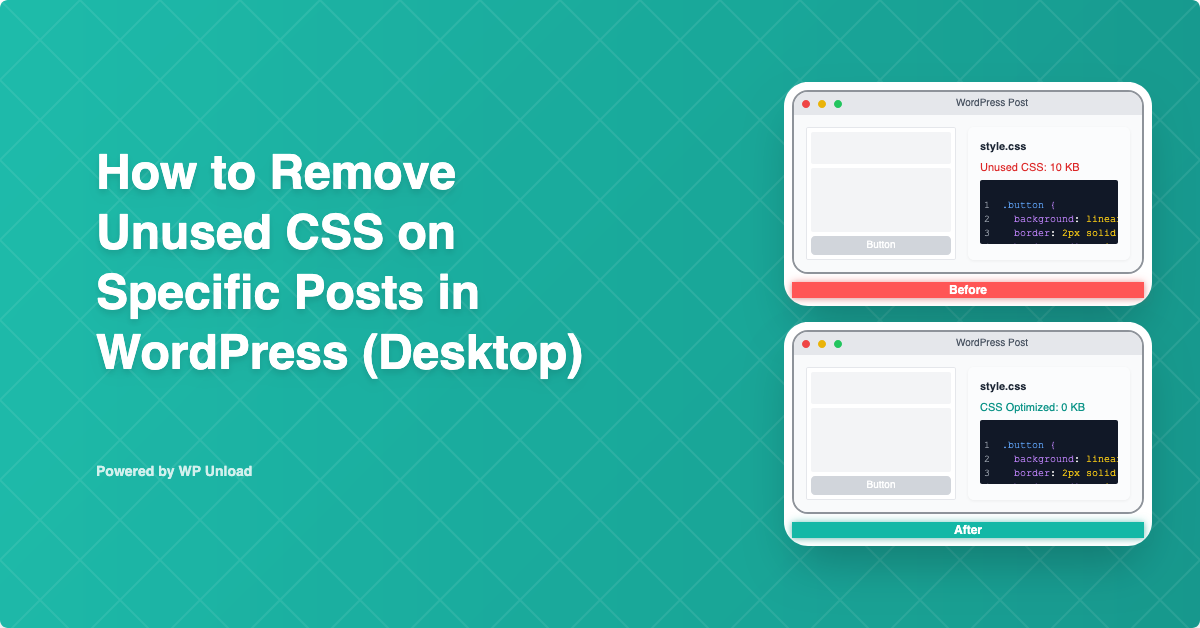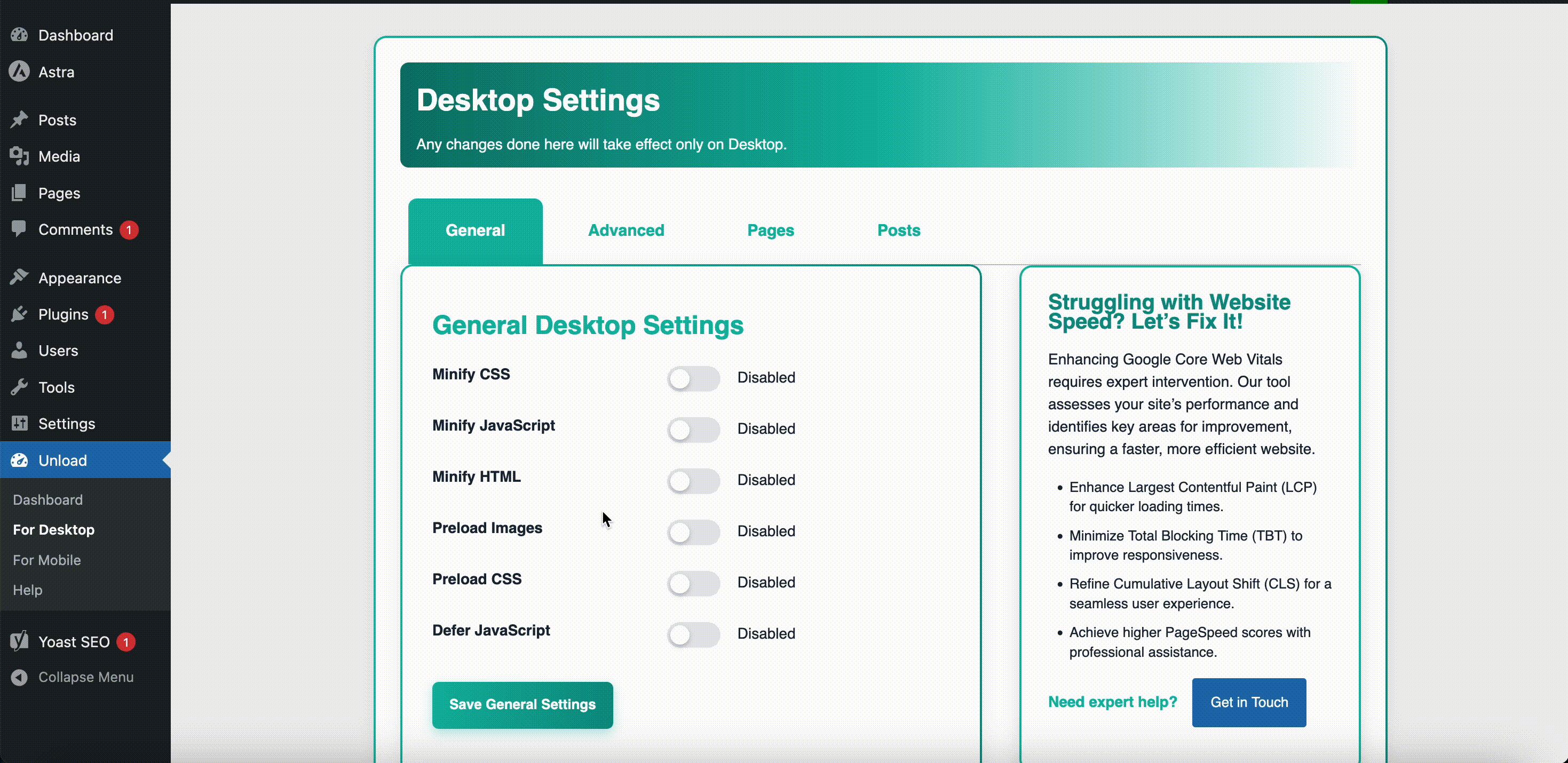Do specific WordPress posts load slowly? Unused CSS—styles loaded but not used on a particular post—bloats pages, delays rendering, and harms SEO. Removing unused CSS for specific posts on WordPress with WP Unload Assets optimizes individual posts, boosting Largest Contentful Paint (LCP) and Core Web Vitals. Its one-click “Posts” tab simplifies targeting, no coding needed. This guide shows you how to remove unused CSS for specific posts on WordPress, with steps, screenshots, a video, and tips to enhance post speed.
Why Remove Unused CSS for Specific Posts on WordPress?
Unused CSS, like a 60KB gallery style on a text-only post, slows rendering for that specific post and increases LCP. This bloat hurts user experience and SEO, as Google prioritizes fast sites. For example, removing 70KB of unused CSS from a single post can cut LCP by 0.8s. WP Unload Assets’ post-specific removal outperforms manual methods, offering precision and ease. Here’s why targeting specific posts is key.
Benefits of Removing Unused CSS with WP Unload Assets
- Faster Specific Post Loads: A blog cut 70KB of CSS from a post, reducing LCP by 0.8s.
- Enhanced SEO: Improved LCP boosts rankings, per our guide on optimizing Core Web Vitals in WordPress.
- Post-Specific Precision: Target CSS for individual posts, preserving other styles.
- No Coding Needed: WP Unload Assets’ interface is beginner-friendly.
- Multisite Support: Optimize specific posts per-site or network-wide.
Key Takeaway: Removing unused CSS for specific posts on WordPress boosts speed, SEO, and reader engagement effortlessly.
Challenges Without Removing Unused CSS
Unremoved CSS bloats specific posts, delaying LCP and interactivity. This leads to poor PageSpeed Insights scores, hurting SEO for those posts. Slow posts frustrate readers, raising bounce rates by up to 15% on style-heavy blogs. Dynamic theme or plugin CSS complicates manual removal, risking style errors. WP Unload Assets automates removing unused CSS for specific posts on WordPress, ensuring safe, efficient optimization.
How to Remove Unused CSS for Specific Posts on WordPress
Let’s dive into removing unused CSS for specific posts on WordPress using WP Unload Assets (version 1.1.0). These beginner-friendly steps, compatible with WordPress 6.3+ and themes like Astra or Divi, include screenshots, a video tutorial, and code snippets for proof.
Step 1: Install WP Unload Assets
Visit our homepage to download WP Unload Assets. Follow these steps:
- Log in to your WordPress dashboard (
yourwebsite.com/wp-admin). - Go to Plugins > Add New > Upload Plugin.
- Upload the WP Unload Assets ZIP file and click Install Now.
- Activate the plugin to access its “WP Unload Assets” menu.
This lightweight plugin (under 200KB) won’t slow your site.
Step 2: Activate Your License
Unlock full features by activating your license:
- Navigate to WP Unload Assets in the WordPress admin sidebar.
- Enter your license key (e.g.,
xxxx-xxxx-xxxx-xxxxxxx) from your purchase email. - Click Activate License. A “License Status: Active” message confirms success.
Proof: The license activation screen unlocks all optimization tools.
Pro Tip: Back up your site before activation and test on a staging environment for high-traffic sites.
Step 3: Open the “Posts” Tab
In the WP Unload Assets dashboard, go to the Posts tab. This displays all posts and their CSS files. For example, a specific text-only post might load gallery.css (60KB) unnecessarily.
Step 4: Remove Unused CSS for a Specific Post
To remove unused CSS for a specific post, navigate to the For Desktop section in the WP Unload Assets dashboard:
- Click the Posts tab to view your posts.
- Choose the specific post you want to optimize (e.g., a text-only blog post).
- Identify unused CSS files (e.g.,
gallery.css) and, optionally, JavaScript files (e.g.,slider.js) to remove. - Add the post’s URL to the removal list by pasting it into the provided field.
- Click Save Changes to apply the removal.
- Test the post to confirm removal by opening it in a browser, accessing Chrome DevTools (F12), and searching for the file (e.g.,
gallery.css) using Ctrl+F. If the file is no longer present, the removal was successful.
Proof: Removing gallery.css (60KB) from a specific post cut LCP by 0.6s. For example:
/* Before: Loaded on Specific Post */
.gallery { display: grid; } /* 60KB */
/* After: Removed via WP Unload Assets */
Video Tutorial: How to Remove Unused CSS for Specific Posts on WordPress
Watch our step-by-step video to see how to remove unused CSS for specific posts on WordPress using WP Unload Assets: Optimize Specific WordPress Posts by Removing Unused CSS!
This video illustrates the process outlined in Step 4, showcasing how to navigate the “For Desktop” section, select a post, and remove unused CSS for specific posts on WordPress.
Troubleshooting Common Issues
- Styles Break: If layouts fail (e.g., misaligned text), enable “Safe Mode” in the Advanced tab to exclude dynamic CSS (e.g., Elementor styles).
- Changes Not Visible: Clear your cache using WP Unload Assets’ “Purge Cache” button.
- Theme Conflicts: Use Chrome DevTools’ Coverage tab to identify essential CSS (e.g., Divi core styles) and exclude them.
/* Identifying Unused CSS with Chrome DevTools */
1. Open Chrome DevTools (F12).
2. Go to Sources > Coverage.
3. Record and check unused CSS files (e.g., gallery.css).
Key Takeaway: WP Unload Assets ensures precise, safe CSS removal for specific posts.
Step 5: Verify Your Results
Test with Google PageSpeed Insights to measure LCP and speed improvements for the specific post. A news site removed 65KB of CSS from a post, boosting its PageSpeed score from 63 to 86. WP Unload Assets integrates with PageSpeed Insights for real-time metrics.
Proof: Post-removal, LCP and PageSpeed scores improved significantly for the targeted post.
Before and After Performance Results
To visualize the impact of removing unused CSS for specific posts on WordPress, compare PageSpeed Insights results before and after:
- Before: The specific post had an LCP of 3.7 seconds, indicating slow rendering.

- After: After removal with WP Unload Assets, LCP dropped to 2.6 seconds, boosting the PageSpeed score by 23 points.

How to Interpret: A lower LCP (e.g., 2.6s vs. 3.7s) means faster rendering for the specific post, improving user experience and SEO. Check the “Diagnostics” section in PageSpeed Insights for targeted CSS recommendations. For deeper analysis, use Google Lighthouse to audit LCP and identify bottlenecks.
Advanced Tips to Optimize Specific WordPress Posts
Maximize performance by combining CSS removal with these WP Unload Assets features for specific posts.
Minify CSS
Minify remaining CSS to reduce file sizes for targeted posts:
/* Before: 12KB */
.header { margin: 10px; padding: 15px; }
/* After: 10KB */
.header{margin:10px;padding:15px}
Explore our guide on minifying CSS in WordPress.
Preload Critical CSS
Preload key styles for faster rendering on specific posts:
<link rel="preload" href="/wp-content/themes/theme/core.css" as="style">
See our guide on preloading CSS in WordPress.
Case Study: Tech Blog
A tech blog removed 75KB of unused CSS (e.g., widget.css) from specific review posts using WP Unload Assets. LCP dropped from 3.7s to 2.6s, increasing ad revenue by 15% as the posts ranked higher for “tech review WordPress speed.”
Key Takeaway: WP Unload Assets’ advanced tools deliver top-tier performance for specific posts.
Common Pitfalls to Avoid
When removing unused CSS for specific posts on WordPress, avoid these mistakes:
- Over-Removing CSS: Removing essential styles (e.g., Divi core CSS) breaks layouts. Use “Safe Mode” or Chrome DevTools to verify.
- Ignoring Mobile: Optimize for mobile too, per our guide on removing unused CSS for mobile WordPress.
- Skipping Tests: Test across browsers (Chrome, Firefox, Safari) using BrowserStack to ensure styles render correctly.
- Neglecting Other Bottlenecks: Pair CSS removal with JavaScript optimization, as detailed in our guide on removing unused JavaScript for WordPress posts.
Why Choose WP Unload Assets?
WP Unload Assets is the ultimate plugin for removing unused CSS for specific posts on WordPress, offering:
- One-Click Simplicity: Disable CSS in seconds, no coding needed.
- Post-Specific Control: Target individual posts, unlike WP Rocket’s broad approach.
- Flexible Optimization: Fine-tune for any device, ensuring universal performance.
- Core Web Vitals Focus: Improve LCP, FCP, and SEO effortlessly.
- Multisite Ready: Optimize specific posts per-site or network-wide.
Unlike Autoptimize’s manual tweaks, WP Unload Assets automates optimization, saving time and ensuring results.
Get Your Specific Posts Moving Today
Removing unused CSS for specific posts on WordPress with WP Unload Assets transforms your posts’ speed, SEO, and reader experience. Its “Posts” tab, screenshots, video tutorial, and advanced features make targeting individual posts effortless. Whether you run a blog, news site, or portfolio, this plugin delivers fast, SEO-friendly posts. Visit our homepage to get WP Unload Assets and supercharge your specific WordPress posts now!



